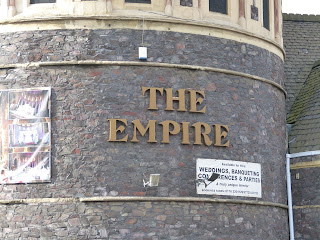Leicester North is the southern terminus of the Great Central Railway. It is not the best way, transport-wise, of getting from Loughborough to Leicester as it takes much longer and costs much more (on gala days at least) than the main railway, and leaves you on the outside of the outer ring road (aka the middle of nowhere). This of course never use to be the case as the tracks used to continue into the heart of the city.
At least the GCR has restored some of the link, and provides a fine two-track heritage railway.
The current station building dates from 2002.
A shortish trek south brings us to the Abbey Pumping Station on Corporation Road (a great civic name for a road). This is now a great, free entry, museum with all sorts of fascinating exhibits, the best of which have to be the magnificent beam engines. If you are ever in the area you really ought to pay a visit.
Anyway, there is also a clock on one of the outbuildings.
Which as it now houses the visitor toilets, it is appropriate that it is a Gents clock.
Next up is Leicester College, and its building off Belgrave Gate.
You can get a glimpse of it from the northern edge of the city centre, peering under the concrete flyover of the ring road and to the left of the tastefully coloured large shed of a building. Not the greatest part of the city.
The building was originally the church of St Mark, built in 1869 - 72. Actually quite difficult to find any information as most web searches refer you to the Empire in Leicester Square, London.
I love this next clock. Quite brutal in its design, and sort of out of place in relation to its surroundings.
Leicester seems to have a bit of an obsession with clock towers (hurrah), and so we get this beauty on the pavilion building of Victoria Park. The park itself is quite an odd place (for which read good), with a large open space with a huge Lutyens-designed war memorial on one edge and this clock tower on another. Oh, and also flanked by the architecturally diverse University of Leicester buildings.
The pavilion was either built in 1948 or 1958, depending on which website you believe. The park itself was opened in 1882.
This is Clarendon Park Congregational Church (completed 1886) on the junction of London Road and Springfield Road.
A nice piece of carved clock face, just a bit useless without the hands.
So let's move on to the University of Leicester, and more specifically the Rattray Lecture Theatre.
That blue blob on the wall is this little beauty. And of course this is another clock featured in "An Introduction to the History of Timekeeping - The Leicester Time-Trail" by Allan Mills. The astronomical clock uses "three independent quartz crystal oscillators to generate impulses based on solar, lunar and sidereal time".
It was installed in 1989, and is 8 feet in diameter.
You can see this next clock from all sorts of different vantage points, but it was quite difficult to pin down what it actually was. Clearly another clock tower, but part of which building? Or was it a standalone folly, or remnant of a demolished structure?
Turns out it is actually part of the fire station, which is also the headquarters for the county brigade. It is certainly more fancy that any fire station tower that I have seen before (perhaps there could be another blog on fire station towers - although probably there already is. I must check later).
The fire station is in Lancaster Road by the way.
Why The Counting House? Because this used to be the counting house for the livestock market. Although the land all around is now various retail units, some obvious clues to its former use can be found on the boundary railings:
Although the weather vane on top of the tower is a bit confusing!
The market was open from 1872 to 1988. The counting house was converted to its present use in 1996.
Time for another tower? Of course, this is Leicester, the world capital of clock towers. This is the National Gas Museum in Aylestone Road. Built in the 1870's, the building is the gatehouse to the former gas works.
The National Gas Museum (although I doubt that there are many local gas museums) was opened on 29 April 1977 - we probably all should go there next year to celebrate its 40 birthday. It houses the "world's largest and most significant gas history collection" (www.nationalgasmuseum.org.uk). Although I would never have paid a visit if it wasn't for the clock, it is a surprisingly interesting experience. And it is free, so what have you got to lose?
More industrial buildings, another clock tower. This time we are in Knighton Fields Road East, at the impressive Wheatsheaf Works.
Long closed as a factory, it is now being converted into residential accommodation. A shame really, but at least it means that this impressive brick building is saved from demolition.
And finally, not really Leicester at all, but the town of Wigston to the south of the city. and if you thought that the National Gas Museum was a bit specialist, Wigston is the home of the Framework Knitters Museum. Unfortunately it was closed on the day I visited.
This is All Saints church.










































































